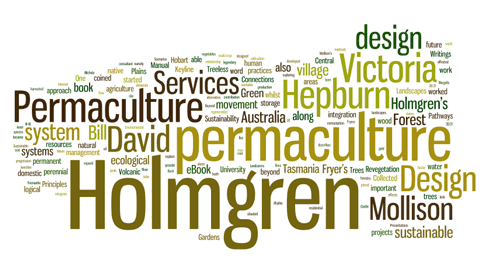Within the permaculture movement, David Holmgren, along with Bill Mollison is responsible for actually creating and developing what we now know as permaculture. This occurred whilst Holmgren and Mollison worked together at the University of Tasmania in Australia; both had a keen interest in exploring the relationship between human and natural systems.
Co-founder of permaculture
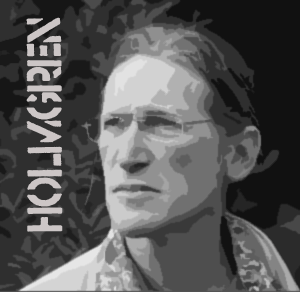 David Holmgren along with Bill Mollison are the originators of the permaculture design system, According to Holmgren, “The word permaculture was coined by Bill Mollison and myself in the mid-1970s to describe an “integrated, evolving system of perennial or self-perpetuating plant and animal species useful to man”. Mollison claims “I coined the term ‘permaculture’ for the system the two jointly developed, which he describes as “a framework for a sustainable agricultural system based on a multi-crop of perennial trees, shrubs, herbs (vegetables and weeds), fungi and root systems”. The word itself is a contraction of the words ‘permanent’ and ‘agriculture’.
David Holmgren along with Bill Mollison are the originators of the permaculture design system, According to Holmgren, “The word permaculture was coined by Bill Mollison and myself in the mid-1970s to describe an “integrated, evolving system of perennial or self-perpetuating plant and animal species useful to man”. Mollison claims “I coined the term ‘permaculture’ for the system the two jointly developed, which he describes as “a framework for a sustainable agricultural system based on a multi-crop of perennial trees, shrubs, herbs (vegetables and weeds), fungi and root systems”. The word itself is a contraction of the words ‘permanent’ and ‘agriculture’.
Background
David Holmgren was born in 1955 in Fremantle in Western Australia, Holmgren joined the Environmental Design School in Hobart, Tasmania in 1973, and it was whilst studying at Hobart that Holmgren first he met Bill Mollison, who was then a lecturer at the University of Tasmania. Holmgren started writing a thesis on sustainable agriculture and, with additions from Mollison, this text became the legendary and seminal book ‘Permaculture One’, which really kick started the permaculture movement in existence.
The work of David Holmgren
Holmgren is an ecologist, ecological design engineer, a design consultant and a writer, he also teaches permaculture courses in his native Australia. Holmgren’s work includes the setting up of a an eco village called Fryer’s Forest Ecovillage, which is situated near Castle Maine in central Australia, Fryer’s Forest village is designed along permaculture lines, and incorporates solar passive houses, sustainable management of native bush land systems.
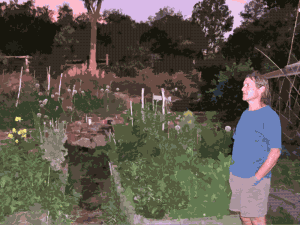 There are some important and crucial permaculture design elements with Fryer’s Forest village, namely the integration of domestic forestry with the selective thinning of trees for fire-safety (the harvested wood provides fuel for domestic wood stoves), the integration of the Keyline design system of water storage, and transfer with the village road network and residential home site location. The water Keyline storage system is the main design instrument for the regeneration of a landscape degraded by over 50 years of gold mining.
There are some important and crucial permaculture design elements with Fryer’s Forest village, namely the integration of domestic forestry with the selective thinning of trees for fire-safety (the harvested wood provides fuel for domestic wood stoves), the integration of the Keyline design system of water storage, and transfer with the village road network and residential home site location. The water Keyline storage system is the main design instrument for the regeneration of a landscape degraded by over 50 years of gold mining.
Holmgren has also been involved in projects which integrate permaculture practices in forest fire management; he has also worked on projects that rejuvenate and enhance the fertility of landscapes affected by volcanoes and volcanic lava flow which were previously barren due to the effects of the Lava.
Holmgren and the development of a future permanent culture
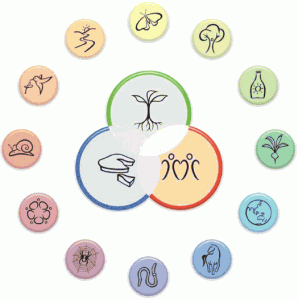 Holmgren’s approach and contribution to permaculture has been to expand permaculture design into all areas of human activity, so that it goes beyond its application in sustainable ecological food production. This single factor alone has been able to provide strategies and practices which inform the Transitions movement and offer multiple solutions to different areas of energy consumption.
Holmgren’s approach and contribution to permaculture has been to expand permaculture design into all areas of human activity, so that it goes beyond its application in sustainable ecological food production. This single factor alone has been able to provide strategies and practices which inform the Transitions movement and offer multiple solutions to different areas of energy consumption.
Holmgren’s logical, methodical and philosophical approach to permaculture, which differs considerably from that of Mollison’s, helps to clearly display its credibility as a workable alternative that is able to replace many of the oil reliant methods of working with resources within the natural world. David Holmgren’s 2002 book ‘Permaculture: Principles and Pathways Beyond Sustainability’ maps out a logical permaculture progression for the future, outside of the design and cultivation end of permaculture, this book is probably one of the most important publications in realistically dealing with a peak in resources and the ensuing ecological degradation that comes from this usage.
In the video below Dave Holmgren talks about the need to move beyond the lulling hope that ‘green tech’ breakthroughs will allow world-wide ‘sustainable consumption’ to the recognition that dwindling oil supplies inevitably mean a mandatory ‘energy descent’ for human civilization across the planet. He argues that permaculture principles provide the best guide to a peaceful societal ‘powering down.” Film provided by Ecological Options Network
David Holmgren Publications
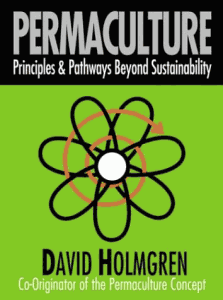 1978 Bill Mollison and David Holmgren. Permaculture One: A Perennial Agriculture for Human Settlements. Melbourne: Transworld.
1978 Bill Mollison and David Holmgren. Permaculture One: A Perennial Agriculture for Human Settlements. Melbourne: Transworld.
1985 Permaculture in the Bush. Hepburn, Victoria: Holmgren Design Services.
1994 Trees on the Treeless Plains: Revegetation Manual for Volcanic Landscapes of Central Victoria. Hepburn, Victoria: Holmgren Design Services.
1995 ‘The Permaculture Movement and Education’, in Goldfields Permaculture and Landcarers, 3, 14-16.
1996 a Melliodora (Hepburn Permaculture Gardens): Ten Years of Sustainable Living. Hepburn, Victoria: Holmgren Design Services.
1996 b ‘Fryers Forest Village’, in Green Connections, 2.2, 20-21.
1997 ‘Getting Started’, in Green Connections, 10, 28-31.
2002 a Permaculture: Principles and Pathways beyond Sustainability. Hepburn, Victoria: Holmgren Design Services.
2002 b David Holmgren: Collected Writings 1978-2000. [CD] Hepburn, Victoria: Holmgren Design Services.
2005 Mellidora (Hepburn Permaculture Gardens): A Case Study in Cool Climate Permaculture 1985 – 2005 [eBook] Hepburn, Victoria: Holmgren Design Services.
2006 a Trees on the Treeless Plains: Revegetation Manual for Volcanic Landscapes of Central Victoria. [eBook] Hepburn, Victoria: Holmgren Design Services.
2006 b David Holmgren: Collected Writings & Presentations 1978 – 2006 [eBook] Hepburn, Victoria: Holmgren Design Services.
2009 Future Scenarios. White River Junction, VT: Chelsea Green Publishing Company.
2011 2011 Permaculture Diary Marrickville NSW: PcDC Michele Margolis.

